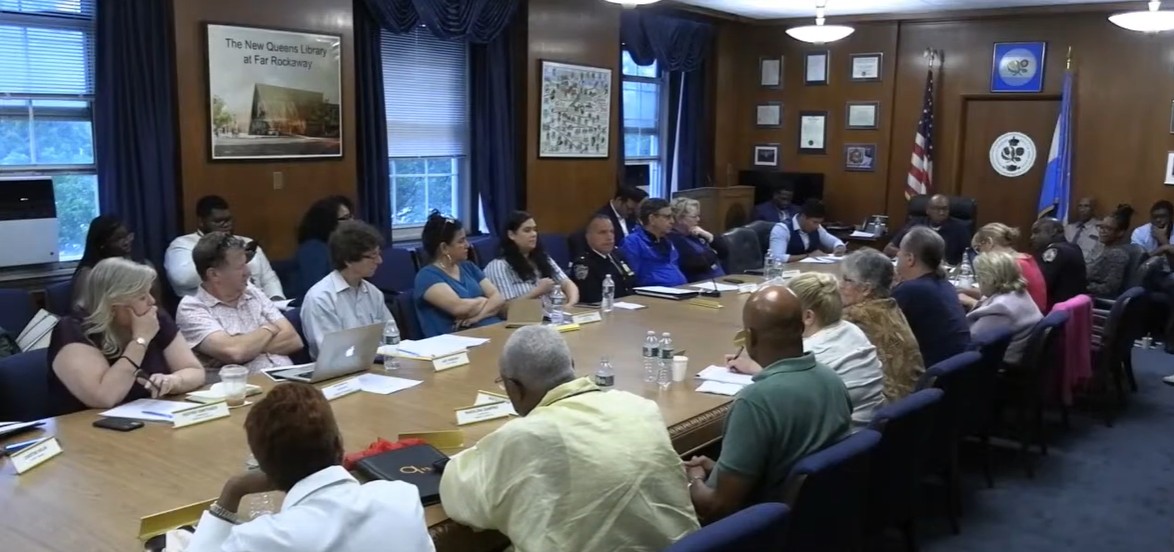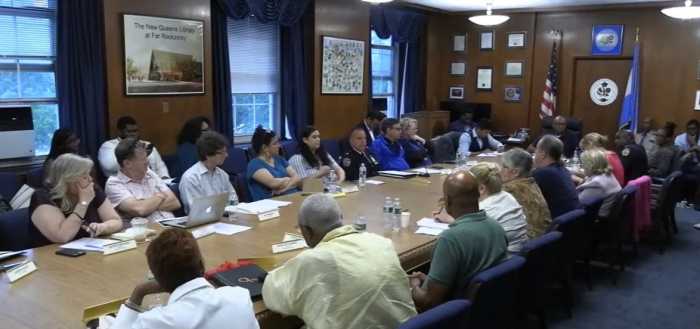Butt out of Union Sq., Stringer!
To The Editor:
Re “Stringer: First course of action on restaurant is review in Albany” (news article, June 29):
I am ideologically opposed to the use of public space for private enterprise. I believe the city must take responsibility for its parks and relying on private money is a dangerous slippery slope — often opening the doors for the government to neglect its responsibility.
As the city councilmember whose district includes Union Square Park, I allocated $1.9 million dollars for the reconstruction of the playground. The recent revisions by Commissioner William Castro and the Bloomberg administration came after several months of objections and negotiations from myself and the community. The final decision to revise the restoration plan was expressed to me in a letter dated June 3, 2005, by Commissioner Castro.
What the new revisions call for is an expanded playground — to almost 15,000 square feet — where children can run and play, and parents can watch them without fear. The Greenmarket will be repaved and the pavilion restored to its original beauty and stature. The revised plan will allow the current seasonal restaurant to continue operating.
The suggestion that the New York State Legislature could or should have a say in Union Square Park, is politicking at its worst. There is nothing new about the seasonal restaurant; it has been in Union Square for 12 years. There was plenty of opportunity over that time — but especially in the early ’90s, when the seasonal restaurant was first proposed — for Assemblymember Stringer to rid the park of private business. By Assemblymember Stringer’s reasoning, the Greenmarket, which is privately owned, would need to go, as well.
Moreover, we have seen how our city has been hurt by what Albany has done with control over schools, rent-control and -stabilization laws and equal access for the disabled and elderly. To suggest Albany should now have say over our parks would give away what doesn’t belong to them, and is out of touch with the needs of Manhattan.
Margarita Lopez
Lopez is city councilmember for the 2nd District
Turns the tables on Partnership
To The Editor:
Re “Restaurant offers Union Sq. a serving of right stuff” (talking point, by Karen H. Shaw, June 29):
I really had to laugh when I read in Karen Shaw’s talking point about Union Square that “thousands and thousands of people flock to this park daily to enjoy and use the restaurant.” Sure. Thousands of people do come to the park every day to eat — but they are barred from the private restaurant now occupying the public’s space.
During most daytime hours, when “thousands and thousands” of people want to enjoy the park, this exclusive restaurant, which is usurping park space, has mostly empty tables, while park benches are crowded with throngs of diners balancing lunches on their laps. Some lucky ones get to sit at the few picnic tables available, and many others loll about on the grass with the food they bring in from outside the park. Even at lunchtime, pictures we’ve taken on two different days confirm this stark contrast: many empty tables at the restaurant versus crowds of diners on benches. On another day, another observer counted a mere eight occupied tables at the restaurant — out of a total of 60 tables!
This restaurant does most of its business at night, largely from the bar, and its supporters try to claim that this makes the park safe. But the Union Square Partneship’s just-released annual report celebrates the vibrant nature of this community, pointing out that shops in the area are open till midnight weekdays and Saturdays, and till 9 p.m. or 10 p.m. on Sundays. There are well over 100 restaurants within a few blocks of the park, including sidewalk cafes on the east and west sides, a big Barnes & Noble store to the north, plus Whole Foods, Filene’s Basement, Virgin record store and others to the south. This is a lively community that hardly needs a drinking crowd at Luna Park to ensure its safety. Ms. Shaw has been executive director of the partnership for only a few years — yet she asserts that the park was crime ridden and unsafe a decade ago. Not so. Once the park was handsomely remodeled in the late ’80s, during Henry Stern’s first tenure as Parks commissioner, everything turned around. Of course, the farmers market helped, and it was also community people, spurred on by Evelyn Strouse, who came in evenings to take back the park for the public.
Ms. Shaw avers that opponents of the restaurant “imply that all private uses in the park are inherently negative.” Again, this is simply not so. There are many instances, such as large parks, where such concessions may be perfectly acceptable, but not in a small heavily used park like Union Square. It is the exclusive nature of this restaurant that we particularly object to. That’s why there are empty tables, despite the fact that the rest of the park is crowded. Note the different situation at Madison Square Park. The tables and chairs near the Shake Shack are available to all members of the public, regardless of whether or not they are customers of this concession.
There is another question here — namely the use of the historic pavilion, which has been allowed to deteriorate. The city has the obligation to restore it for the many public uses it can again provide: as a bandstand, as a performance space, as a platform for rallies and as a sheltered recreation area.
Carol Greitzer
Greitzer was a New York City councilmember from 1969-’91.
Restaurant underused by day
To The Editor:
Re “Restaurant offers Union Sq. a serving of right stuff” (talking point, by Karen H. Shaw, June 29):
The claim by the Union Square business improvement district’s Karen H. Shaw that “the restaurant [in Union Square Park] adds immeasurably to the enjoyment, safety and security of all parkgoers — all day and particularly at night” should not go unchallenged.
On a recent summer Saturday (June 25), at noon, only eight tables of the 60 available in the private outdoor restaurant concession were occupied. By contrast, the park’s benches and picnic tables were filled to capacity by lunchtime munchers and seekers of a free place in the sun.
There used to be free picnic tables in the restaurant space, too, until it was privatized 12 years ago into an upscale operation that most people can’t afford — ironically, in this most proletarian and populist of all New York City public parks.
Jack Taylor
Let my (H.D.F.C.) people go
To The Editor:
“Tenants want to make profit, but nonprofit stands in the way” (news article, June 29):
It is disappointing to learn of the struggles some H.D.F.C. tenants are experiencing from — of all organizations — local nonprofit housing organizations, founded upon many ennobling principles, not the least being that the tenants they are privileged to serve will someday become fully independent — fully enabled to help themselves. This view has an inherent anticipation that the folk, but for a few minor setbacks, shall ultimately exercise their own God-given ability to care completely for themselves. No matter the degree of technical assistance provided, or financial resources expended, it fully anticipates the day when tenants are unimpeded and no longer dependent on the goodwill and best intentions of the housing organization that served them. Legal arguments notwithstanding, the big picture is that this day might have arrived for the tenants specified in the article. Any organization that thinks otherwise betrays that conviction, betrays the very tenants they assisted along the years and ultimately betrays its own raison d’etre.
Disappointment arises especially from a seeming betrayal of what was thought all Lower East Side housing organizations seemed to have really believed, summed up perhaps (however one interprets its inherent meaning) within an often exclaimed, but simply-put scriptural-based phrase shared in boisterous but effective demonstrations for housing justice: “Let My People Go.” The need for assistance was acute if one remembers the ’80s. Housing organization rose to the occasion because low-income families were being held back and in dire need of affordable housing on the Lower East Side. Housing organizations joined the struggle with them, not for them and never with the intention to permanently supplant their independence or their innate abilities to ultimately make decisions on their own.
Ownership should not be a question. The tenants own the buildings. Every legal document would seem to support that aim. Legal wrangling aside, tenant ownership was and will always remain implicit in the covenants made between housing organizations, the tenants they served and the city of New York. And management should not be a question. Who dares to presume what tenants can easily and justly decide for themselves?
Nonprofit community housing organizations, once the only beacon of hope for the advocacy of, if not for actually securing many units of affordable housing for low-income families, should, at all cost, resist temptations to succumb to the vagaries of the real estate dynamics on the Lower East Side. They should completely trust the people they serve to go it alone. They should come to terms with the fact that their services as such, though highly appreciated over the years, are perhaps no longer necessary.
Victor J. Papa
Papa is president, Two Bridges Neighborhood Council
Bicyclists are run amok
To The Editor:
We are all for the safety and benefits of biking but what about the safety of pedestrians when trying to cross streets and on sidewalks? What about the liability when delivery people are the worst offenders?
Ron and Sue Elvena

































